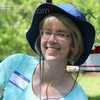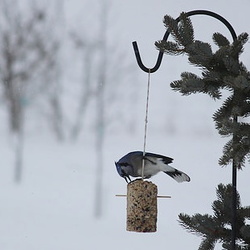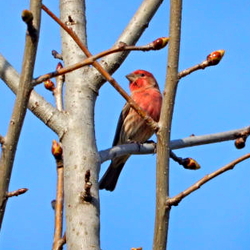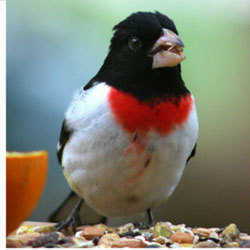Birdwatching takes on a whole new dimension when you add birdlistening to your outdoor skills. For years, I took birdsong for granted. A few guided birdwalks showed me the light. Experienced birders can tell who's flitting about even before those birds can be seen. If you just listen for birds and learn their voices, you don't even have to see them to enjoy their company. Bird background music for gardening--It's analogous to playing a radio while you clean house. I get a kick out of knowing who's out there in my yard without even trying to see them. Many times, I'm much more successful at knowing who's in my yard by hearing their chatter than by visually confirming their presence. After all, I don't usually wear binoculars in my own yard, but I always have my ears.
Well, about the goose in my tree... Even an amateur birdwatcher/birdlistener like me knows that Canada geese are rarely found climbing trees in waterless suburban landscapes. What the heck was making that goose-like call? A careful scan of my sycamore revealed not a big honking goose, but a cute little clinging bird. As an amateur birder, I first checked my handy Cornell "Common Feeder Birds of Eastern North America" poster. It had already given me a name for 99% ofthe feathered visitors to my yard. Sure enough, on the poster I saw "MY" bird, a white-breasted nuthatch. This bird reminds you of a chickadee or titmouse because of its small body, black cap and white and grey body markings. But where a chickadee perches perkily on twigs, a white-breasted nuthatch is mostly found bellying up to tree trunks or branches. It nimbly climbs, head up or head down, in search of bugs. The nuthatch also has a distinctively long slender bill, unlike the short bill of the chickadee, which it uses to reach for hidden bugs or pick apart stubborn seeds.You may see white-breasted nuthatches in the company of other favorite backyard birds in winter flocks, like titmice, chickadees and downy woodpeckers. A woodland bird, nuthatches are well adapted to the forest-edge-like suburban gardens that many homeowners favor as well. The white-breasted nuthatch, or its close relatives, are common across the North American continent. Redbreasted, brown-headed and pygmy nuthatches pretty much round out the U. S. and Canadian nuthatch family tree, giving just about every North American birdwatcher a nuthatch for company in the great outdoors. Other species of nuthatches exist worldwide for our international Dave's Garden membership to enjoy. Wherever trees grow, some type of nuthatch can probably be found.

While Canada geese and white-breasted nuthatches share a black-white-gray color scheme, they have other major differences. Geese are large waterfowl, while nuthatches are tiny woodland birds. You won't confuse the two if you see them! The pictures above and to the left show that providing suet in winter is a great way to lure nuthatches into camera range and earshot.
I nailed down this ID, and learned a bit more about nuthatches, by also checking a few guides and websites. Many internet birding sites have links to bird call recordings. Take this link and click on "call" to hear my nuthatches' neighbors from the Patuxent Wildlife Research Center just a few miles down the road from me. Doesn't the nuthatch at least sound more like a goose than a robin or other typical backyard bird? I've linked to the white-breasted nuthatch page of several websites below, which can serve as your jumping off spot for investigating whatever feathered creatures you're seeing or hearing nearby. I've also listed two birding books that I use. These two display birds in color illustrations, but if you prefer you can also find photographic field guides.
You might do your garden a favor by encouraging these birds in your yard throughout winter. They're likely to visit your feeders for suet or seed. As payoff, you can hope they stick around in the warm months to prey on various insects and spiders in the yard. Fresh water is a must when winter is dry and frozen, as it has been lately in the Mid-Atlantic region. In return, maintaining a more natural, organic space will encourage nuthatches and other songbirds to hang around for your viewing and listening pleasure. Skip the birdhouse though; white-breasted nuthatch prefers to make its own nest rather than use a box you put up.
Has this article piqued your interest in birding? You're just in time for the annual Great Backyard Bird Count. Clicking on that name will take you to the project's website and show you all you need to participate. It looks simple; I think I'll do it this year for the first time. And I don't expect to have any Canada geese to report in my yard, just nuthatches and friends.
Resources and credits
*Books
Peterson, Roger Tory. Peterson Field Gides: Eastern Birds (fourth edition). Boston, Houghton Mifflin, 1980.
Scott, Shirley L, ed. Field Guide to the Birds of North America. (National Geographic Society). Washington D. C., National Geographic Society, 1983.
*Internet
Nuthatch information and the above linked nuthatch audio found at:
Gough, G.A., Sauer, J.R., Iliff, M. Patuxent Bird Identification Infocenter. 1998. Version 97.1. Patuxent Wildlife Research Center, Laurel, MD. http://www.mbr-pwrc.usgs.gov/id/framlst/infocenter.html
Sialis.org ~ white-breasted nuthatch page, Home page states "This website was developed as a resource for people interested in helping bluebirds and other native cavity-nesters survive and thrive."
Whatbird.com ~ WB nuthatch ~ All about birds, featuring a unique "search engine used to identify birds of North America."
Audobon.org, white-breasted nuthatch page- technically quite detailed but inclusive of random anecdotes as well
Megan Cheatham's page about "her favorite bird"
Cornell Lab of Ornithology~ white-breasted nuthatch
*Dave's Garden Articles
Attracting and Keeping our Feathered Friends, the Songbirds by Paul Rodman
Winter Survival for Northern Birds by Marna Towne
Recycle Your Christmas Tree! Make a Peanut Butter Feeder from a Section of its Trunk to Attract Birds to Your Garden by Jill M. Nicolaus
This is For the Birds! by Toni Leland
Nuthatch thumbnail picture and Canada goose picture taken by and property of DG subscriber claypa and found in DG Birdfiles. Nuthatch photo in body of article taken by and property of author.

















